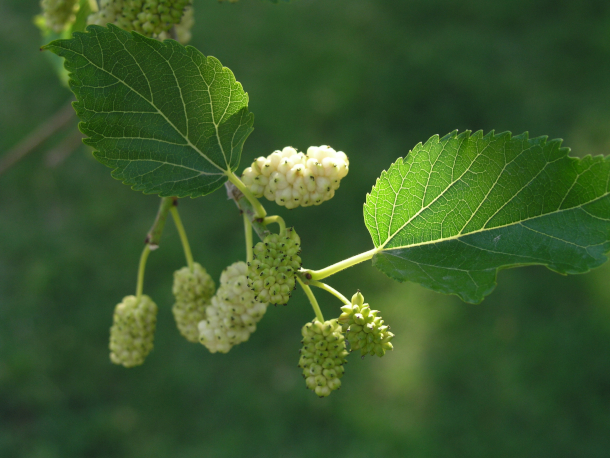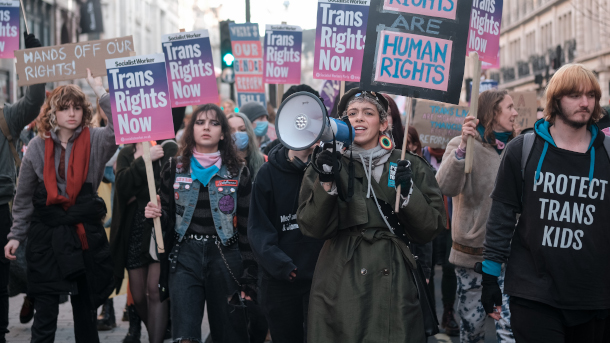An Introduction to Queer Ecology
Air Date: Week of June 23, 2023

White mulberry trees have been known to change sex, from male (those that produce pollen) to female (those that produce fruit) and vice versa. They also sometimes produce fruit and pollen from the same plant. (Photo: Luis Fernández García L. Fdez, Wikimedia Commons, CC BY-SA 2.1 ES)
The academic discipline known as “queer ecology” looks at environmental politics through a queer lens, rejecting heterosexual and cisgender identities as the only norms. Host Aynsley O’Neill speaks with Cate Sandilands, who coined the term ‘queer ecology’ in the 1990s, about diverse displays of gender and sexuality in nature, as well as how queer resistance can make an impact in the fight against the climate crisis.
Transcript
DOERING: It’s Living on Earth, I’m Jenni Doering.
O’NEILL: And I’m Aynsley O’Neill.
June is Pride Month in the United States, a time to celebrate the LGBTQIA+ community. That’s a group that includes lesbian, gay, bisexual, transgender, queer or questioning, intersex, and asexual people. So we wanted to take a look at some of the diverse displays of gender and sexuality that are found in nature. For example, take the New Mexico whiptail, an all-female species of lizard that reproduces asexually. Or consider the seahorse, where the female partner lays the eggs that the male partner becomes pregnant with. While situations like these break our societal norms of gender and sexuality, that doesn't make them any less natural, and that’s one of the key themes of the academic discipline known as "queer ecology". The idea of "queer ecology" connects the worlds of queer theory and environmental politics, by examining the environment through a lens that rejects heterosexual and cisgender identities as the only norms. Cate Sandilands is a writer, scholar and professor in the faculty of Environment and Urban Change at York University in Toronto. She originally coined the term “queer ecology” in the 1990s and she joins me now. Thank you for being here, Cate!
SANDILANDS: Thank you very much Aynsley.
O'NEILL: So, what are some standouts, or possibly some of your favorite examples of the queerness of gender and sexuality in nature.
SANDILANDS: There are many, many examples. Some of the ones that are held out as the most significant are examples that can be found in our relatively close primate relatives. One quite famous example are bonobos, who, let's say have very rich sexual and social lives that do not necessarily have anything to do with procreation and the creation of the next generation. Some of the examples that I like the best, however, come from my focus on the plant kingdom. And at one level plants are sexually very different kinds of beings than homosapiens. The idea that a plant possesses a sex or gender is actually a bit of an alien concept. However, one of my favorite examples of a delightfully queer plant is mulberry trees. Mulberries are, at least white mulberries, Morus alba, are normally dioecious, which means that there are pollen producing, quote, male trees and also pollen receiving, quote, female trees, the female ones being the ones that --- having received the pollen --- produce berries. But it gets a little bit more complicated because some mulberries in certain conditions are monoecious, meaning that they both produce and receive pollen. So they're both male and female. Mulberries also change sex quite frequently. The mulberry orchardist, to their immense frustration will you know, sort of one year discover that a certain proportion of their trees have decided to become male, thereby not producing fruit. And the reverse can also be true. But one of my favorite mulberry stories is that because they're a very fast growing quite beautiful, I think, and pollution-resistant tree, they are highly favored as street trees. And the trees that are favored as street trees tend to be the male trees because they don't produce large amounts of purple splats on the sidewalk. And precisely those male clonally reproduced trees are becoming a real problem, because they are producing prolific amounts of pollen. So they're actually also one of the most allergenic trees in the world. You cannot legally plant mulberry trees in some cities in the United States for this very reason. So, I like this story, because it demonstrates that this attempt to use sex as a way of controlling the trees' behavior completely backfired. And the trees kind of got their revenge. So, I'm fascinated with mulberry trees, because I am sort of fascinated by the complexity and diversity of sexual expressions in the more than human world. But I also think that thinking about sexual diversity and in fact, sex change as a relatively banal fact, of the multispecies universe, it's actually really important to emphasize that.

The concept of ‘queer ecology’ intersects with the fight for queer liberation and the fight for climate justice. (Photo: Alisdare Hickson, Flickr, CC BY-SA 2.0)
O'NEILL: What impact does looking at nature through this queer lens have on us as humans, not just the LGBTQIA+ community but the whole world?
SANDILANDS: I think that understanding nature as far queer, far more ritually sexually complicated, far more corporeally complicated and gender complicated. Thinking about the world in those terms, and not through the narrow lens of reproductive heteronormativity is, first of all, it's a very humbling experience to imagine that you know, what we as humans happen to do, or think or understand about ourselves as sexual beings is a tiny, tiny, tiny piece in a marvelously complicated universe. But politically, it also really challenges the idea that reproductive heterosexuality is the one natural way of doing reproduction and doing sex, and at a variety of different political moments, but I would say particularly at this political moment, that's pretty powerful evidence against the argument that queer and trans embodiments, queer and trans behaviors are somehow unnatural. And we see that rhetoric of unnaturalness occurring in, for example, the criminalization of homosexuality in Uganda, and also in arguments against providing gender affirming care for youth in Florida. The idea is that somehow that homosexual activity, homosexual attraction is unnatural, and the idea that trans embodiment is somehow against nature, that we're interfering with sort of the natural course of adolescent development by providing gender affirming care. The idea of queer nature really calls those rhetorics into question.
O’NEILL: How can we use queer ecology as a tool to help us fight the climate crisis?

There are many LGBTQIA+, and especially queer, trans and BIPOC networks of farmers who have found ways to creatively use the land and provide mutual aid for one another through practices like organic farming. (Photo: Markus Winkler, Unsplash)
SANDILANDS: I think queer ecology is one of a number of nodes of creative resistance to the economic, social, political, ecological relationships that are creating the climate crisis. I don't think that queer ecology is the only way to go. But I think that drawing on LGBTQIA+ histories of resistance and thinking seriously about the ways in which our intimate relationships can be other than tied to petrocapitalism, I think that's why queer ecology is actually pretty important at this moment. And that in current conditions, we see a flourishing of queer forms of land and property ownership. There's a number of queer networks and also more specifically QTBIPOC, queer trans BIPOC, networks of farmers who are grappling with these multiple forms of relationship and multiple forms of creatively providing mutual aid in times of economic crisis and that mutual aid extending to include better relationships with our more than human kin, either through organic agriculture, for example, or forms of thoughtful ecological restoration.
O’NEILL: Cate Sandilands is a writer, scholar and professor in the Faculty of Environment and Urban Change at York University. Cate, thank you so much for taking the time with me today.
SANDILANDS: It was my pleasure. Thank you, Aynsley.
Links
Learn more about Cate Sandilands and explore her extensive body of work.
Read more about the many examples of queerness in gender and sexuality in nature.
Living on Earth wants to hear from you!
Living on Earth
62 Calef Highway, Suite 212
Lee, NH 03861
Telephone: 617-287-4121
E-mail: comments@loe.org
Newsletter [Click here]
Donate to Living on Earth!
Living on Earth is an independent media program and relies entirely on contributions from listeners and institutions supporting public service. Please donate now to preserve an independent environmental voice.
NewsletterLiving on Earth offers a weekly delivery of the show's rundown to your mailbox. Sign up for our newsletter today!
 Sailors For The Sea: Be the change you want to sea.
Sailors For The Sea: Be the change you want to sea.
 The Grantham Foundation for the Protection of the Environment: Committed to protecting and improving the health of the global environment.
The Grantham Foundation for the Protection of the Environment: Committed to protecting and improving the health of the global environment.
 Contribute to Living on Earth and receive, as our gift to you, an archival print of one of Mark Seth Lender's extraordinary wildlife photographs. Follow the link to see Mark's current collection of photographs.
Contribute to Living on Earth and receive, as our gift to you, an archival print of one of Mark Seth Lender's extraordinary wildlife photographs. Follow the link to see Mark's current collection of photographs.
 Buy a signed copy of Mark Seth Lender's book Smeagull the Seagull & support Living on Earth
Buy a signed copy of Mark Seth Lender's book Smeagull the Seagull & support Living on Earth

